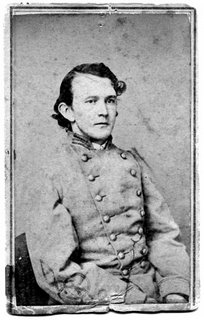This morning, I completed a project that has been on my desk for about six months. It is the story of Lt. Col. James O’Brien of the Forty-eighth Massachusetts Infantry, a noble Irish-American cut down in battle while leading his men against the almost impenetrable defenses of Port Hudson on May 27, 1863.
What makes his story particularly interesting is the recent discovery of a photograph of his body lying in state in the Charlestown City Hall. This is the first such image I’ve ever seen. The image was part of a scrapbook assembled by one of O’Brien’s sons in 1883 — twenty years after his father’s death.
I found out about this scrapbook back in 2002 while researching O’Brien’s life and military service for my first book. A family member alerted me to its existence after reading
my post on Genforum.com, but, for various reasons, never produced copies of the photo and the other pages of the scrapbook, which includes letters, newspaper clippings, and other documents. I published O’Brien’s story without the benefit of this information.
Earlier this year, I received an email from Reggie Van Driest, also responding to my post. He had recently purchased a
carte de visite of O’Brien (the same view published in my book) and was eager for details. I shared with him the information about he scrapbook. Reggie pursued the lead, and it paid off: He learned that a CD full of scans of the scrapbook had been donated to the
New England Historic Genealogical Society. Soon, we had copies and were both blown away by the amount of original source material — and, of course, the wonderful image of his coffin at city hall.
Based on this new information, and my earlier work, I wrote a story focused on O’Brien’s death in battle, and the yearlong journey that took his remains from a temporary interment in New Orleans to his final resting place in Massachusetts. Reggie provided captions for the coffin image and his
carte de visite portrait of O’Brien. The article and images have been submitted to Editor Dave Neville at
Military Images Magazine, in which the story will eventually appear.


